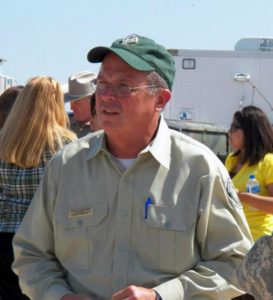Stanford retires after 43 years with Texas A&M Forest Service
Led evolution in firefighting, fire management for Texas
Mark Stanford, associate director for Forest Resource Protection and fire chief at Texas A&M Forest Service, is retiring after 43 years of service.

Stanford began his career with Texas A&M Forest Service in 1979 as a forester and served in six other positions, including chief of fire operations.
Through his leadership, service and life’s work, Stanford has helped elevate incident response capabilities at the local, state and national levels.
Lifelong contributions
Stanford helped develop the Rural Volunteer Fire Department Assistance and Insurance Programs, both passed by the Texas Legislature in 2001. The programs continue to positively impact local volunteer fire departments across the state. To date, the Rural Volunteer Fire Department Assistance Program has provided over 2,000 fire trucks, 10,000 pieces of fire/rescue and personal protective equipment, and training to over 93,000 firefighters across the state.
Stanford provided the vision and oversight of the Texas A&M Forest Service Emergency Operations Center, EOC, which serves as a command hub for statewide incident management. Incident response leaders have managed large, regional incidents such as hurricanes Katrina, Rita, Ike and Harvey as well as several historic wildfire seasons, including the 2011 Texas wildfire season, from the EOC.
Continuously improving efficiencies and accountability, Stanford oversaw the development of web-based fire reporting systems for Texas A&M Forest Service and the state’s 1,800 fire departments.
The reporting program was so successful that the Federal Emergency Management Association, FEMA, recognized it as the only accurate means of determining the appropriate reimbursement of costs to fire departments during the 2005-2006 Presidential Emergency Declaration. It was through these efforts that fire departments were able to acquire millions of dollars in FEMA reimbursements, leading to the National Association of State Foresters seeking Texas A&M Forest Service to design a national wildfire reporting system and a fire department survey.
Stanford also oversaw the development of Texas Wildfire Risk Assessment Portal, or TxWRAP. This online tool was launched in 2012 to help Texans better prepare and protect themselves from wildfires. TxWRAP allows homeowners, civic planners and elected officials to identify local wildfire risks and access resources to help them better prepare for wildfires and mitigate fire hazards.
Stanford’s leadership can be seen not only in the way the Texas A&M Forest Service organizes and communicates in wildland fire, but also in the way that they fight it.
Texas Wildfire Protection Plan
The Texas Wildfire Protection Plan, TWPP, is a multi-disciplinary approach to meeting the wildfire threat across the Lone Star State. Stanford was instrumental in developing and implementing the plan, helping to frame fire management as an approach that incorporates prevention, mitigation, capacity building, planning and preparedness, and incident response across Texas.
The tiered approach to protecting against wildfires recognizes that all incidents begin and end at the local level, and that volunteer fire departments are the critical first line of defense. Building the capacity of fire departments, local governments and other cooperators is key to protecting Texas. TWPP received funding from the Texas Legislature in 1999, 2009 and 2013, enabling the addition of 188 state firefighters.
This TWPP model ensured the agency’s successful response through many major incidents during Stanford’s tenure as fire chief, including 10 major wildfire seasons, 12 hurricanes and tropical storms, 10 major flood events, six tornadoes and nine major winter storms.
Stanford’s work and influence spanned beyond the Texas borders, as he served on numerous national committees, including the National Wildfire Coordinating Group, NWCG, International Foam Task Group, Roscommon Equipment Center Project Committee, NWCG Fire Engine Subcommittee, Western Governors Association Prescribed Fire Steering Committee, the Federal Wildland Fire Management Policy and Program Review Team, and the Leadership Development Committee of the National Wildfire Coordinating Group.
Accolades
Stanford has received numerous awards throughout his career including the Texas A&M University System Regents Service Fellow, a Vice Chancellor’s Award in Excellence for forestry, an Agricultural Program Leadership Award, and Public Service and Community Building Award.
He was also a recipient of the National Association of State Foresters John Roberts Partnership Award, both the NASA Public Service Medal and Astronaut Office Service Award in 2003 for leadership during the Space Shuttle Columbia recovery effort. In addition, Stanford was honored by the National Wildland Fire Leadership Development Committee from the National Wildfire Coordinating Group.
Stanford was not only a leader in the wildland fire community – he also taught leadership. Living his mantra of knowing what he believes in and doing the right thing, he helped develop the agency’s Leadership Enrichment Program, Mentor Program and Wildland Fire Responder Academy.
It is for these achievements and his great service to the State of Texas that Stanford will be remembered into the future within the wildland fire program at Texas A&M Forest Service.


